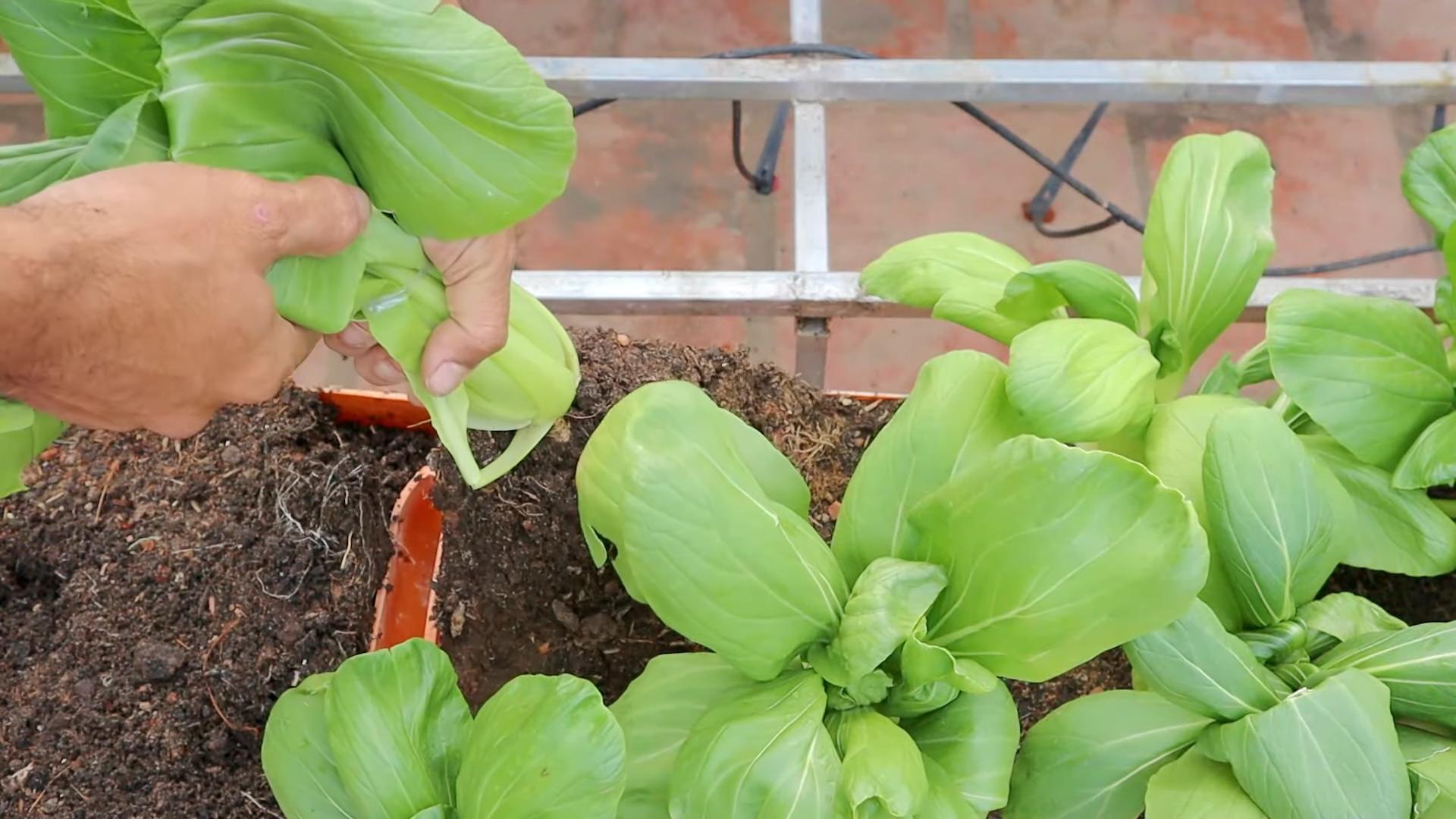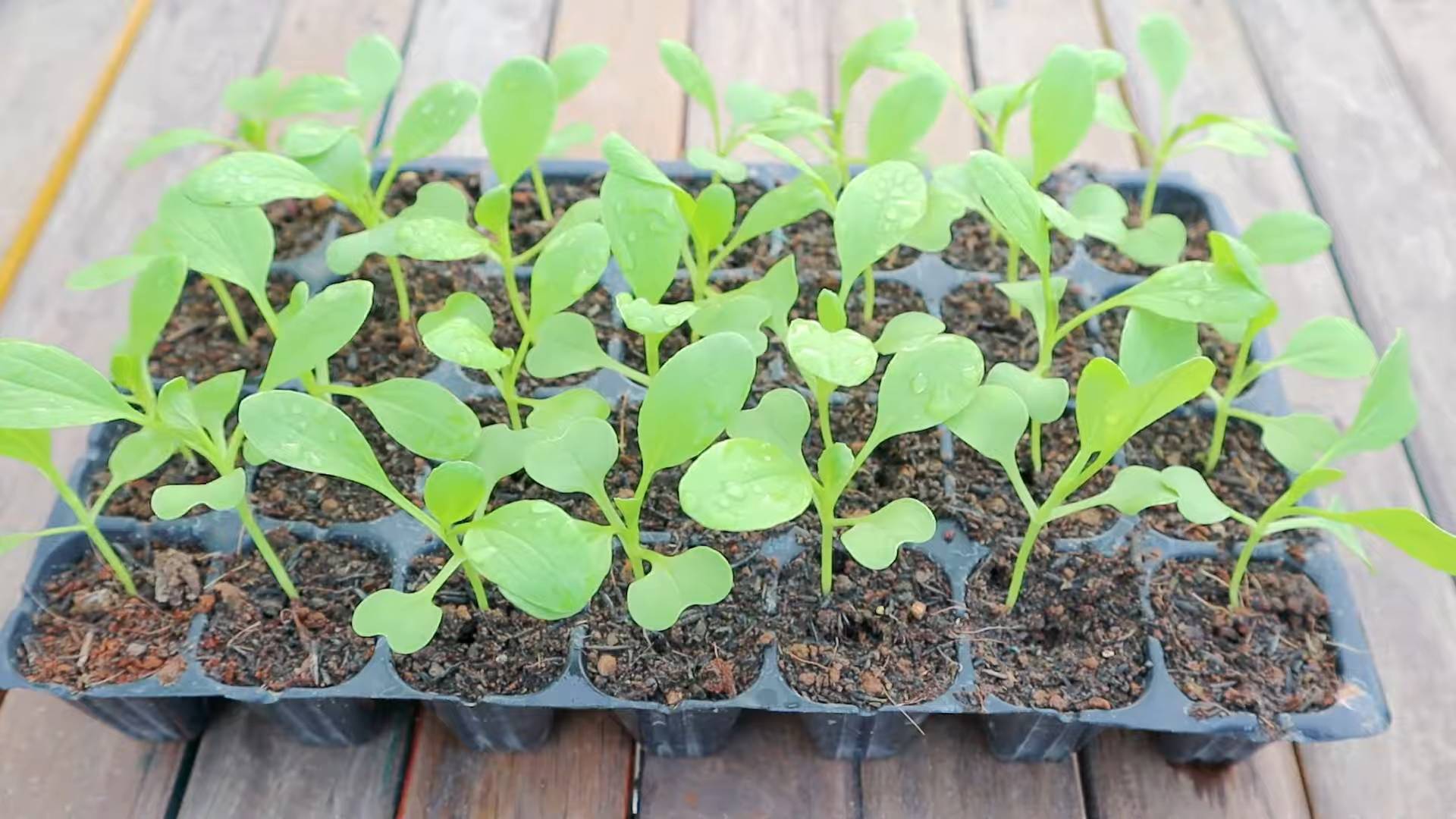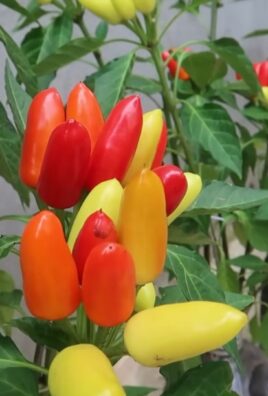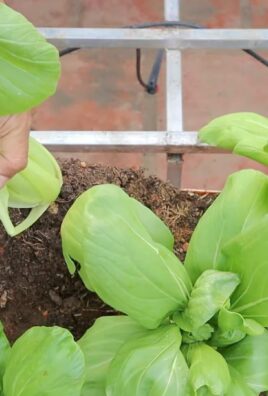Grow Bok Choy Home – sounds intimidating, right? Don’t worry, it’s easier than you think! Forget those expensive grocery store trips for wilted, sad-looking bok choy. I’m here to show you how to cultivate your own vibrant, delicious bok choy right in your backyard (or even on your balcony!).
Bok choy, also known as pak choi, has been a staple in Asian cuisine for centuries, with roots tracing back to ancient China. It’s not just delicious; it’s packed with vitamins and nutrients, making it a super healthy addition to your diet. Plus, there’s something incredibly satisfying about harvesting your own food, connecting with nature, and knowing exactly where your meals come from.
But why should you bother with DIY gardening, especially when it comes to bok choy? Well, for starters, homegrown bok choy tastes infinitely better than store-bought. It’s fresher, crisper, and bursting with flavor. More importantly, growing your own allows you to control what goes into your food – no harmful pesticides or chemicals! In this article, I’ll share my favorite home gardening tricks and DIY hacks to help you successfully grow bok choy home, even if you’re a complete beginner. Get ready to unleash your inner gardener and enjoy the bountiful rewards of your own fresh, healthy bok choy!

Growing Bok Choy at Home: A Beginner’s Guide
Hey there, fellow gardening enthusiasts! I’m so excited to share my experience with growing bok choy at home. It’s surprisingly easy, and nothing beats the taste of fresh, homegrown veggies. Bok choy, also known as pak choi, is a type of Chinese cabbage that’s packed with nutrients and adds a delicious crunch to stir-fries, soups, and salads. Let’s dive into how you can cultivate your own little bok choy patch!
Choosing the Right Bok Choy Variety
First things first, let’s talk about varieties. There are several types of bok choy, each with slightly different characteristics. Here are a few popular options:
* Shanghai Bok Choy: This variety has light green stems and spoon-shaped leaves. It’s known for its mild flavor and tender texture.
* Baby Bok Choy: As the name suggests, this is a smaller version of regular bok choy. It’s perfect for single servings and cooks quickly.
* Joi Choi: This is a larger variety with dark green leaves and thick, white stems. It’s more heat-tolerant than some other types.
* Mei Qing Choi: This is a compact variety with light green leaves and a mild flavor. It’s a good choice for smaller gardens or containers.
I personally love growing Shanghai bok choy because of its delicate flavor, but feel free to experiment and find your favorite!
Getting Started: Seeds vs. Seedlings
You have two options when starting your bok choy journey: seeds or seedlings.
* Seeds: Starting from seeds gives you more control over the entire growing process. Plus, it’s generally more economical.
* Seedlings: Buying seedlings is a quicker way to get started. It’s a good option if you’re short on time or don’t have a lot of space for seed starting.
I usually start from seeds because I enjoy watching them sprout and grow. But if you’re a beginner, seedlings can be a great way to get your feet wet.
Preparing the Soil
Bok choy thrives in well-drained, fertile soil. Here’s how to prepare your soil:
* Choose a sunny location: Bok choy needs at least 4-6 hours of sunlight per day.
* Amend the soil: Mix in plenty of compost or well-rotted manure to improve drainage and fertility. Bok choy loves nutrient-rich soil!
* Check the pH: Bok choy prefers a soil pH between 6.0 and 7.5. You can test your soil pH with a home testing kit or send a sample to your local agricultural extension office.
* Loosen the soil: Use a garden fork or tiller to loosen the soil to a depth of at least 12 inches. This will allow the roots to grow easily.
Planting Bok Choy
Now for the fun part: planting!
Planting from Seeds:
1. Sow seeds directly in the garden: You can sow seeds directly into the garden about 2-4 weeks before the last expected frost in spring, or in late summer for a fall harvest. Bok choy prefers cooler temperatures.
2. Create shallow furrows: Make shallow furrows about ½ inch deep and 1-2 inches apart.
3. Sow the seeds: Sprinkle the seeds evenly in the furrows.
4. Cover the seeds: Gently cover the seeds with soil.
5. Water gently: Water the soil gently to avoid washing away the seeds.
6. Thin seedlings: Once the seedlings emerge and have a few true leaves, thin them to about 6-8 inches apart. This will give them enough space to grow.
Planting Seedlings:
1. Dig holes: Dig holes that are slightly larger than the root ball of the seedlings. Space the holes about 6-8 inches apart.
2. Remove seedlings from containers: Gently remove the seedlings from their containers, being careful not to damage the roots.
3. Place seedlings in holes: Place the seedlings in the holes and backfill with soil.
4. Water thoroughly: Water the seedlings thoroughly after planting.
Caring for Your Bok Choy
Once your bok choy is planted, it’s important to provide proper care to ensure a healthy and bountiful harvest.
* Watering: Bok choy needs consistent moisture, especially during hot weather. Water deeply whenever the top inch of soil feels dry. Avoid overhead watering, as this can lead to fungal diseases.
* Fertilizing: Feed your bok choy with a balanced fertilizer every 2-3 weeks. You can use a liquid fertilizer or a slow-release granular fertilizer. Follow the instructions on the fertilizer package.
* Weeding: Keep the area around your bok choy free of weeds. Weeds compete with bok choy for nutrients and water.
* Pest Control: Bok choy can be susceptible to pests such as aphids, cabbage worms, and flea beetles. Inspect your plants regularly and take action if you see any signs of infestation. You can use insecticidal soap, neem oil, or handpick the pests off the plants.
* Bolting: Bolting is when the plant prematurely flowers and goes to seed. This can happen when the weather gets too hot. To prevent bolting, plant bok choy in a shady location during the summer months or choose heat-tolerant varieties.
Harvesting Bok Choy
You can start harvesting bok choy when the leaves are about 6-8 inches long.
* Cut the entire plant: You can cut the entire plant at the base with a sharp knife.
* Harvest individual leaves: Alternatively, you can harvest individual leaves as needed, starting with the outer leaves. This will allow the plant to continue producing new leaves.
I usually harvest the entire plant when it’s reached a good size, but harvesting individual leaves is a great option if you want to enjoy fresh bok choy over a longer period.
Troubleshooting Common Problems
Even with the best care, you might encounter some problems while growing bok choy. Here are a few common issues and how to address them:
* Aphids: These tiny pests can suck the sap from bok choy leaves, causing them to become distorted and yellow. Spray aphids with insecticidal soap or neem oil.
* Cabbage Worms: These green caterpillars can devour bok choy leaves. Handpick them off the plants or use Bacillus thuringiensis (Bt), a natural insecticide.
* Flea Beetles: These small, jumping beetles can create tiny holes in bok choy leaves. Cover your plants with row covers to prevent flea beetles from reaching them.
* Downy Mildew: This fungal disease can cause yellow spots on bok choy leaves. Improve air circulation around your plants and avoid overhead watering. You can also use a fungicide if necessary.
* Bolting: As mentioned earlier, bolting can occur when the weather gets too hot. Plant bok choy in a shady location during the summer months or choose heat-tolerant varieties.
Enjoying Your Homegrown Bok Choy
Now that you’ve harvested your beautiful bok choy, it’s time to enjoy the fruits (or rather, vegetables) of your labor! Bok choy is incredibly versatile and can be used in a variety of dishes.
* Stir-fries: Bok choy is a classic ingredient in stir-fries. Simply chop it up and add it to your favorite stir-fry recipe.
* Soups: Bok choy adds a delicious crunch and flavor to soups. Add it to your favorite soup recipe during the last few minutes of cooking.
* Salads: Baby bok choy can be used in salads. Its tender leaves and mild flavor make it a great addition to any salad.
* Steaming: Steaming bok choy is a quick and easy way to cook it. Simply steam it for a few minutes until it’s tender-crisp.
* Grilling: Grilling bok choy adds a smoky flavor. Brush it with olive oil and grill it for a few minutes per side.
I personally love adding bok choy to my stir-fries. It adds a wonderful crunch and a subtle sweetness that complements other vegetables and proteins perfectly.
Growing Bok Choy in Containers
Don’t have a garden? No problem! You can easily grow bok choy in containers.
* Choose a container: Select a container that is at least 12 inches deep and wide. Make sure the container has drainage holes.
* Use a good quality potting mix: Fill the container with a good quality potting mix.
* Plant the seeds or seedlings: Plant the seeds or seedlings as described above.
* Water and fertilize regularly: Water the container regularly, especially during hot weather. Fertilize every 2-3 weeks with a balanced fertilizer.
* Place the container in a sunny

Conclusion
So, there you have it! Growing your own bok choy at home is not only achievable, but it’s also incredibly rewarding. From the crisp, fresh taste that surpasses anything you can find in a grocery store to the sheer satisfaction of nurturing a plant from seed to harvest, this DIY project is a must-try for any home gardener, regardless of experience level.
Why is this a must-try? Because you’re taking control of your food source. You know exactly what goes into your bok choy – no mystery pesticides or long-distance transportation. You’re also saving money in the long run, especially if you regularly enjoy this nutritious leafy green. And let’s not forget the environmental benefits of reducing your carbon footprint by growing locally.
But the best part? The flavor! Homegrown bok choy boasts a tenderness and subtle sweetness that store-bought varieties often lack. Imagine stir-fries bursting with vibrant green leaves, soups enriched with a delicate, earthy flavor, or even simply enjoying it raw in a salad with a light vinaigrette. The possibilities are endless.
Ready to take your bok choy game to the next level? Consider these variations:
* Succession Planting: Plant new seeds every few weeks to ensure a continuous harvest throughout the growing season. This way, you’ll always have fresh bok choy on hand.
* Container Gardening: If you’re short on space, bok choy thrives in containers. Choose a pot that’s at least 6 inches deep and wide, and use a well-draining potting mix. This is perfect for balconies or patios.
* Microgreens: Harvest your bok choy seedlings as microgreens for a concentrated burst of flavor and nutrients. They’re great in salads, sandwiches, or as a garnish.
* Different Varieties: Experiment with different varieties of bok choy, such as ‘Joi Choi’ (a larger variety) or ‘Shanghai Green’ (a smaller, more compact variety). Each offers a slightly different flavor and texture.
* Companion Planting: Plant bok choy alongside other vegetables like carrots, radishes, and onions. These companion plants can help deter pests and improve the overall health of your garden.
Don’t be intimidated if you’re a beginner. Growing bok choy at home is surprisingly easy, and the rewards are well worth the effort. Start small, be patient, and don’t be afraid to experiment.
We encourage you to give this DIY trick a try. Plant those seeds, nurture your seedlings, and watch your bok choy flourish. And most importantly, share your experience with us! We’d love to hear about your successes, your challenges, and any tips you’ve discovered along the way. Post photos of your homegrown bok choy on social media and tag us. Let’s create a community of home gardeners who are passionate about fresh, healthy, and delicious food. Happy gardening!
Frequently Asked Questions (FAQ)
What is the best time of year to plant bok choy?
Bok choy is a cool-season crop, meaning it thrives in cooler temperatures. The best time to plant bok choy is in early spring or late summer/early fall. Avoid planting during the hottest months of summer, as the heat can cause the plants to bolt (go to seed prematurely), resulting in a bitter taste. For a spring crop, start seeds indoors 4-6 weeks before the last expected frost. For a fall crop, sow seeds directly into the garden in late summer or early fall, about 4-6 weeks before the first expected frost.
How much sunlight does bok choy need?
Bok choy needs at least 4-6 hours of sunlight per day to grow well. While it can tolerate some shade, especially during the hottest part of the day, insufficient sunlight can result in leggy plants with weak growth. Choose a location in your garden that receives plenty of morning sun and some afternoon shade, especially in warmer climates. If growing indoors, use grow lights to supplement natural sunlight.
What kind of soil is best for growing bok choy?
Bok choy prefers well-draining soil that is rich in organic matter. Amend your garden soil with compost or well-rotted manure before planting to improve drainage and fertility. The ideal soil pH for bok choy is between 6.0 and 7.5. You can test your soil pH using a soil testing kit and amend it accordingly. Avoid heavy clay soils, as they can retain too much moisture and lead to root rot.
How often should I water bok choy?
Bok choy needs consistent moisture to thrive. Water regularly, especially during dry periods, to keep the soil evenly moist but not waterlogged. Aim to water deeply and less frequently, rather than shallowly and more often. Check the soil moisture regularly by sticking your finger into the soil about an inch deep. If the soil feels dry, it’s time to water. Mulching around the plants can help retain moisture in the soil.
What are some common pests and diseases that affect bok choy?
Bok choy can be susceptible to several pests and diseases, including aphids, flea beetles, cabbage worms, and downy mildew. Regularly inspect your plants for signs of pests or diseases. Control aphids and flea beetles with insecticidal soap or neem oil. Handpick cabbage worms off the plants. Prevent downy mildew by providing good air circulation and avoiding overhead watering. Crop rotation can also help prevent soilborne diseases.
How do I harvest bok choy?
You can harvest bok choy at any stage of growth, depending on your preference. For baby bok choy, harvest when the leaves are about 4-6 inches long. For mature bok choy, harvest when the heads are firm and compact. To harvest, simply cut the entire head of bok choy at the base of the plant with a sharp knife. You can also harvest individual leaves as needed, starting with the outer leaves.
How do I store bok choy after harvesting?
After harvesting, rinse the bok choy thoroughly and pat it dry. Store it in a plastic bag in the refrigerator for up to a week. For longer storage, you can blanch the bok choy for 2-3 minutes and then freeze it.
Can I grow bok choy indoors?
Yes, you can grow bok choy indoors, especially if you have a sunny windowsill or grow lights. Choose a pot that is at least 6 inches deep and wide, and use a well-draining potting mix. Provide at least 6 hours of light per day, either from natural sunlight or grow lights. Water regularly and fertilize every few weeks with a balanced fertilizer.
Is bok choy nutritious?
Yes, bok choy is a highly nutritious vegetable. It is a good source of vitamins A, C, and K, as well as folate, calcium, and potassium. It is also low in calories and high in fiber.
Can I eat the entire bok choy plant?
Yes, the entire bok choy plant is edible, including the leaves, stems, and flowers. The stems are slightly more fibrous than the leaves, but they are still delicious when cooked. The flowers are also edible and have a mild, slightly sweet flavor.




Leave a Comment